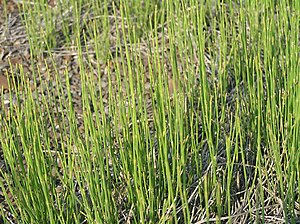Branched horsetail
| Branched horsetail | ||||||||||||
|---|---|---|---|---|---|---|---|---|---|---|---|---|

Branched horsetail ( Equisetum ramosissimum ) |
||||||||||||
| Systematics | ||||||||||||
|
||||||||||||
| Scientific name | ||||||||||||
| Equisetum ramosissimum | ||||||||||||
| Desf. |
The branched horsetail ( Equisetum ramosissimum ) is a species of horsetail ( Equisetum ).
features
The branchy horsetail is a rhizome geophyte . The black rhizome drives fertile and sterile stems above ground , these are lying to upright, mostly knotty, gray-green, reach heights of growth of 10 to 100 cm and diameters of 2 to 9 mm. The stems do not overwinter. Their internodes are 3 to 10 cm long and have 8 to 15 ribs. The central cavity of the stem is slightly wider than half the diameter of the stem. The stem sheaths are funnel-shaped, green, 5 to 22 mm long and 2 to 8 mm wide; they have 8 to 15 teeth that are three times as long as they are wide. The side branches are of unequal length and there are too few in whorls.
The sporangial ear is 6 to 22 mm long, pointed above and enveloped by the uppermost sheath below. The sporangia ripen from June to July.
The number of chromosomes in the branchy horsetail is 2n = 216.
Distribution and location
The knotty horsetail occurs throughout warm and warm-temperate Eurasia , Africa, and South and Central America . It reaches its northern border in Europe in Brittany, southern England, the Netherlands, northern Germany and Poland. It is usually more common in southern Europe than the field horsetail . It rises in the canton of Valais to an altitude of 1450 meters.
The knotty horsetail is light-loving and can only withstand partial shade. It does best on sandy soils or on gravel soils. It inhabits gravel banks, dams, banks, semi- arid grasslands and pine forests, and less often fields. It is often found in societies of the Mesobromion or the Agrostietalia order.
Systematics
Two subspecies can be distinguished:
- Equisetum ramosissimum subsp. debile (Roxb. ex Vaucher) Hauke : It occurs in India, Sri Lanka, Indonesia, the Philippines, Hong Kong and Taiwan.
- Equisetum ramosissimum subsp. ramosissimum : It occurs in Europe, Africa and Asia.
literature
- EJ Jäger, K. Werner: Excursion flora from Germany / greeted by Werner Rothmaler. Volume 4: Vascular Plants: Critical Volume. 9th edition, Spektrum, Heidelberg 2002, ISBN 3-8274-0917-9
- Erich Oberdorfer : Plant-sociological excursion flora for Germany and neighboring areas. 8th edition, Ulmer, Stuttgart 2001, page 64. ISBN 3-8001-3131-5
- Josef Dostál: Equisetaceae. In: Gustav Hegi : Illustrated flora of Central Europe. Volume 1, part I. 3rd edition, Paul Parey publishing house. Berlin, Hamburg 1984, ISBN 3-489-50020-2
- Jaakko Jalas, Juha Suominen: Atlas Florae Europaeae. Volume 1, Pteridophyta. Helsinki 1972.
Individual evidence
- ↑ a b c Equisetum in the Germplasm Resources Information Network (GRIN), USDA , ARS , National Genetic Resources Program. National Germplasm Resources Laboratory, Beltsville, Maryland. Retrieved February 16, 2019.
Web links
- Branched horsetail. In: FloraWeb.de.
- Branched horsetail . In: BiolFlor, the database of biological-ecological characteristics of the flora of Germany.
- Profile and distribution map for Bavaria . In: Botanical Information Hub of Bavaria .
- Equisetum ramosissimum Desf., Map for distribution in Switzerland In: Info Flora , the national data and information center for Swiss flora .
- Thomas Meyer: Horsetail data sheet with identification key and photos at Flora-de: Flora von Deutschland (old name of the website: Flowers in Swabia )
- Data sheet with photos.



